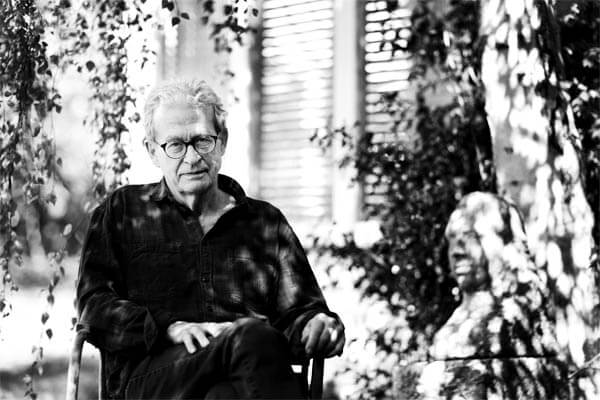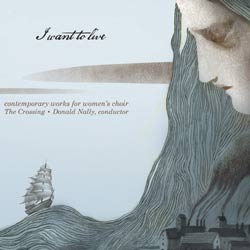 The Philadelphia-based choir The Crossing’s recent CD for Innova Recordings, I want to live , is a showcase for the group’s strong and clear female voices in pieces by David Lang, William Brooks, Paul Fowler, and Pelle Gudmundsen-Holmgreen. The choir has been closely associated with Lang for years and their crystal-clear yet full-bodied tone suits his passionate texts and layered vocal textures perfectly. His pieces are the fleshy part of this album, with the other composers adding some surprising and effectively contrasting sounds and colors. Under conductor Donald Nally’s leadership, the women featured here bring a thrilling new sound to the body of repertoire for women’s choir, influenced heavily by Medieval and Renaissance timbre and text, but with all of the pungent harmonic expression of the modern era.
The Philadelphia-based choir The Crossing’s recent CD for Innova Recordings, I want to live , is a showcase for the group’s strong and clear female voices in pieces by David Lang, William Brooks, Paul Fowler, and Pelle Gudmundsen-Holmgreen. The choir has been closely associated with Lang for years and their crystal-clear yet full-bodied tone suits his passionate texts and layered vocal textures perfectly. His pieces are the fleshy part of this album, with the other composers adding some surprising and effectively contrasting sounds and colors. Under conductor Donald Nally’s leadership, the women featured here bring a thrilling new sound to the body of repertoire for women’s choir, influenced heavily by Medieval and Renaissance timbre and text, but with all of the pungent harmonic expression of the modern era.

The Crossing – Photo: Kevin Gearhart
Lang’s “I live in pain” (2010) is a mesmerizing opener and, with its repeated phrases on a text by the 12th-century troubadour Beatriz de Dia, unfolds steadily into the final, desperate demand of the first-person narrator: “Promise me/ You will do what I say/ Please./ Do what I say.” William Brooks’ Six Medieval Lyrics (2006/2010) was original composed for Trio Medieval, and is here expanded for The Crossing. It explores incredible Medieval love poetry written in Latin, a dramatic turn from the typical church Latin of choral music, and full of colorful images and tormented lovers. Brooks’ music is full of startling effects seamlessly woven into closely-bound harmonies. In one movement, “III. Tu vite subsidium,” soloists Rebecca Siler and Shari Wilson plunge up and down on sudden slides, like frantic gulls diving into the sea, on the lyrics “Tu vite subsidium mortisque suplicium esse poteris (You, life’s sustenance or death’s torment can be).” The fifth movement “Aprili tempore,” is operatic in scope of expression, starting with a gentle hum and silky neutral vowels as Veronica Chapman-Smith’s powerful voice begins this recollection and dream of love scorned. This piece opens up a world of woman’s pain, charity, and passion, here spoken with a wonderful variety of textures and voices, exploring the stages of love in a modern yet timeless way.
Lang’s pensive Yiddish piece “I lie” (2001) is paired with his “this condition” (2005), on a prose selection from Lydia Davis’ short story collection Almost No Memory. The two pieces have entirely different effects and show Lang’s gift for creating unexpected dramatic expression regardless of text, language, or source of the words he chooses. “I lie” is a theatrical visualization of a woman’s life waiting for a man, and the choir perfectly captures its subtle and dark drama. Davis’ text is a long list of objects and Lang uses a simple device to delineate the everyday and unusual items. He writes the voices in punctuated and syllabic rhythms, with only brief, two-part harmonies used initially to color the objects. As the text delves into broader terms (“anything warm, anything wet, anything wet and red…”), the word “anything” becomes an incantation of sorts, achieved by the crisp and emotionless sound of the choir.
The subject matter turns from the specifics of a woman’s life to general and spiritual themes, explored in Paul Fowler’s two Buddhism-inspired pieces “Potter’s Clay” (2007) and “Echoes” (2010), and in Lang’s “evening morning day” (2007), a noun-based telling of the creation myth. Fowler uses chanting, drones, and a combination of Sanskrit and English texts to create luminous and prayer-like pieces, wrought beautifully and simply in female voices. “evening morning day,” like “this condition” is a largely syllabic setting, but the repeating, rising lines illustrate the progression from the first line to the final iteration of “beast earth bird air earth every-creeping-thing life herb/ every-thing evening morning day” in a magical and meditative way. The choir’s diction is simple and direct, allowing Lang’s words to flow freely.

Pelle Gudmundsen-Holmgreen
Danish composer Pelle Gudmundsen-Holmgreen’s “Statements” begins like a simple unison folk or hymn tune, but is soon disrupted by overlapping text and the sudden low exclamation on the word “jump,” which manages to capture the many meanings, exuberant and risky, fearsome and fun, of the word. The brief movements of this piece tell an entire tale using only nouns, until the final statements of the title: “i. it is and it is enough. ii. i make statements and that is all.” The word “i” is given the same treatment as “jump,” and through repeated listening, one can only begin guess at the deep meanings behind this curious piece. The choir sings it with glowing timbre and a gleeful approach. The album closes with the title track, Lang’s “I want to live,” based on a single line of text by Deborah Artman, opening with unison iterations of “I want to live where you live.” The close harmonies layer over one another in three voices, shimmering in yet another prayer-like piece.
 There is a definite theme to the album, and with Lang’s works at the center of it, there is enough variety in text, expression, and vocal colors produced to make the entire CD entrancing. It acts as a stunning exposé on current repertoire for women’s choir; there is a generous helping of the tune cluster sound so popular today, but the exquisite text painting on Brooks’ and Gudmundsen-Holmgreen’s pieces, and wonderful text settings on Fowler and Lang’s pieces, make sure that the generic tone cluster sound is transcended and becomes a vehicle for true sonic exploration of text. The choir, with Nally’s elegant leadership, makes this music a fabulous addition to the recorded repertoire.
There is a definite theme to the album, and with Lang’s works at the center of it, there is enough variety in text, expression, and vocal colors produced to make the entire CD entrancing. It acts as a stunning exposé on current repertoire for women’s choir; there is a generous helping of the tune cluster sound so popular today, but the exquisite text painting on Brooks’ and Gudmundsen-Holmgreen’s pieces, and wonderful text settings on Fowler and Lang’s pieces, make sure that the generic tone cluster sound is transcended and becomes a vehicle for true sonic exploration of text. The choir, with Nally’s elegant leadership, makes this music a fabulous addition to the recorded repertoire.
The Crossing, Donald Nally conductor, I want to live (Innova, 2013) Buy on Amazon.com | Buy on Amazon.ca | Buy on Amazon.co.uk




















